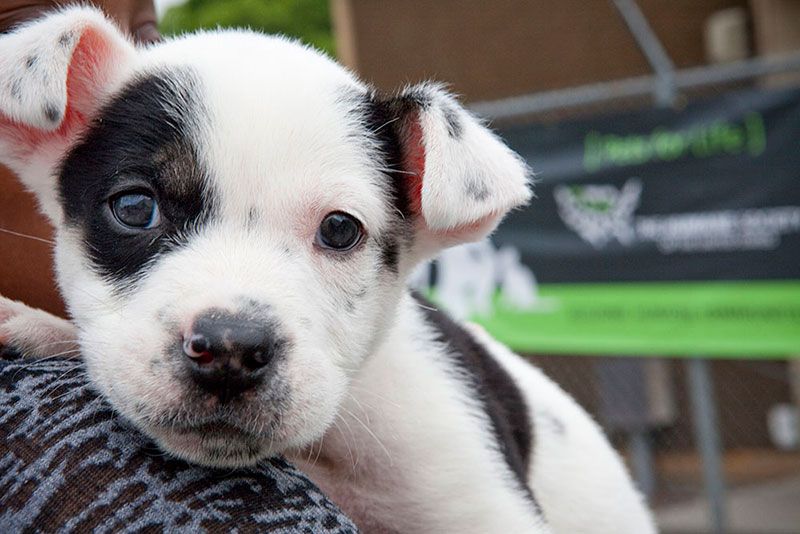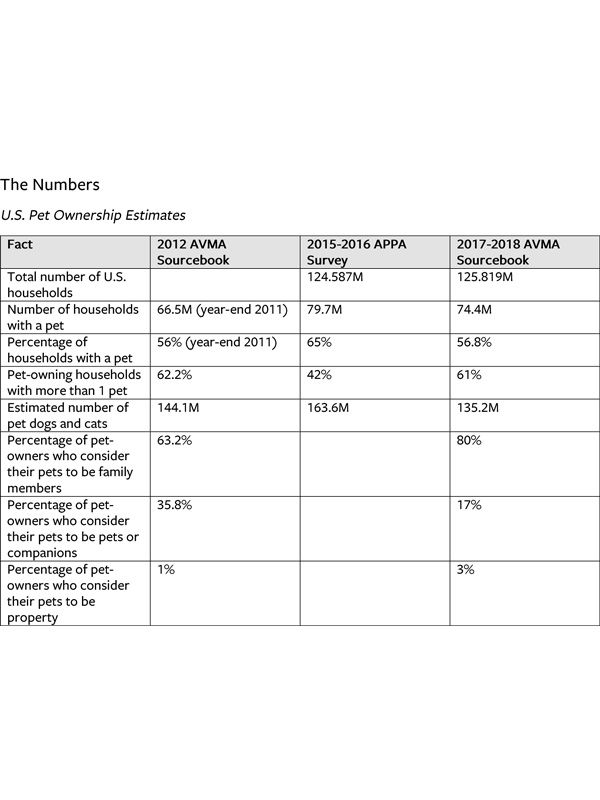Pets by the numbers
Data and statistics on pet ownership, community cat and shelter populations in the United States

Understanding the Data
Obtaining accurate statistical data about pets in the United States isn’t easy. Most of the information is based on estimates derived from two periodic surveys, and the various survey takers do not agree. Data reflecting shelter/rescue animal populations is spotty due to a lack of reporting requirements, which leaders in animal welfare are aiming to address with the Shelter Animals Count project.
There are two main sources of pet demographics in the United States: the biennial APPA National Pet Owners Survey by the American Pet Products Association, and the U.S. Pet Ownership & Demographics Sourcebook by the American Veterinary Medical Association (AVMA) which is published every five years. These surveys provide data about trends in pet ownership and produce estimates of the total number of dogs and cats.
The following is select data from the APPA and the AVMA. For additional information—including questions about how to interpret this data—please reach out directly to the APPA and/or AVMA.
The Numbers
| Fact | 2017-2018 AVMA Sourcebook | 2021-2022 APPA Survey |
|---|---|---|
| Total number of U.S. households | 125.819M | 128.451M |
| Number of households with a pet | 74.4M (59%) | 90.5M* (70%) *In 1988, the APPA estimated 56% of U.S. households owned a pet. |
| Percentage of households that foster pets | 8% | |
| Percentage of pet owners who foster pets | 11% | |
| Percentage of pet-owners who consider their pets to be family members | 80% | |
| Percentage of pet-owners who consider their pets to be pets or companions | 17% | |
| Percentage of pet-owners who consider their pets to be property | 3% |
| Fact | 2017-2018 AVMA Sourcebook | 2021-2022 APPA Survey |
|---|---|---|
| Households that own at least one dog | 48.3M (38%) | 69M (54%) |
| Percentage of U.S. population that owns a dog | 7% | |
| Dog-owning households with small (< 25 lbs) dogs | 47% | |
| Dog-owning households with medium (25-40 lbs) dogs | 31% | |
| Dog-owning households with large (> 40 lbs) dogs | 36% | |
| Percentage of dog owners who consider their dogs to be family members | 85% | |
| Percentage of dog owners who consider their dogs to be pets or companions | 14% | |
| Percentage of dog owners who consider their dogs to be property | 1% | |
| Average amount spent on veterinary visits per year, per household | $495 | $1,344 |
| Percentage of owned dogs who are spayed or neutered | 69.1% | 78% |
| Percentage of dogs who are "pure breed" | 48.7% | 56% |
| Percentage of dogs who are mixed breed/"mutts" | 51.3% | 54% |
| Fact | 2017-2018 AVMA Sourcebook | 2021-2022 APPA Survey |
|---|---|---|
| Households that own at least one cat | 31.9M (25%) | 45.4M (35%) |
| Percentage of U.S. households that foster cats | 5% | |
| Percentage of new cat owners whose decision to acquire a cat was influenced by COVID-19 | 40% overall. 49% male, 33% female. 56% millennial, 40% Gen Z, 27% Baby Boomer and 19% Gen X. | |
| Percentage of cat owners who consider their cats to be family members | 76% | |
| Percentage of cat owners who consider their cats to be pets or companions | 20% | |
| Percentage of cat owners who consider their cats to be property | 3% | |
| Average amount spent on veterinary visits per year, per household | $335 | $801 |
| Percentage of pet cats who are spayed or neutered | 80% | 85% |
| Percentage of cats who are "pure breed" | 16% | 31% |
| Percentage of cats who are mixed breed/"mutts" | 84% | 75% |
| Fact | 2017-2018 AVMA Sourcebook | 2021-2022 APPA Survey |
|---|---|---|
| Dogs adopted from an animal shelter/humane society or rescue group (may include adoptions via pet stores) | 28% | 40% |
| Cats adopted from an animal shelter or rescue group (may include adoptions via pet stores) | 31% | 43% |
| Dogs taken in as strays or caught outside | 5% | 4% |
| Cats taken in as strays or caught outside | 25% | 24% |
| Dogs acquired from friends or relatives | 26% | 18% |
| Cats acquired from friends or relatives | 25% | 21% |
| Dogs purchased from a pet store | 6% | 9% |
| Cats purchased from a pet store | 3% | 8% |
| Dogs purchased from a breeder | 22% | 21% |
| Cats purchased from a breeder | 3% | 4% |
| Dogs bred at home/from owned pet | 4% | |
| Cats bred at home/from owned pet | 7% | |
| Dogs received as a gift | 4% | |
| Cats received as a gift | 3% |
Pet Ownership Estimates from Underserved Communities
While the figures referenced previously tend to reflect mainstream America, the Pets for Life team of Humane World for Animals has spent years working in, and collecting data from, our nation’s most underserved communities which lack access to affordable and available pet resources. We have found startling differences in pet ownership. People living in underserved communities love their pets as much as pet owners anywhere else in the nation. However, there is extreme inequity in access to veterinary care, spay/neuter providers and other services most Americans take for granted, and this difference is reflected in the data:
- Pets living in underserved communities in the U.S.: 22 million
- Percentage of pets living in underserved communities who are not spayed or neutered: 88%
- Percentage of pets living in underserved communities who have never seen a veterinarian: 69%
Learn more about our Pets for Life program
Community Cat Estimates
Cats can be divided into three populations—those who are personal pets, those being cared for by shelters and rescues and those who live their lives out in our communities. Community cats are friendly stray or abandoned cats as well as feral (unsocialized) cats and cats who fall somewhere in between. These cats are unowned, but may be provided with food, water and/or shelter by caring individuals. The HSUS advocates for a trap-neuter-return approach to humanely managing community cats.
- Estimated number of community cats in the U.S.: 30 to 40 million [1]
- Percentage of community cats who are spayed/neutered: Unknown (this will vary by community based on implementation of community cat management strategies)
- Average number of litters produced by an intact female community cat: 1.4 litters/year [2]
- Mean number of kittens in each litter produced by intact community cats: 3 kittens/litter [2]
- Estimated survivorship of community kittens, 0-6 months: 25% [2]
- Estimated annual survivorship of adult community cats: 70% [3]
- Percentage of people who believe leaving a community cat outdoors is preferable to having him or her caught and euthanized: 81% [4]
- Percentage of people in the U.S. providing food for community cats: 10% of the general public and 17% of pet owners feed free-roaming cats. [5, 6]
- Humane World for Animals, Managing community cats: A guide for municipal leaders. 2020. P. 3.
- Nutter, F.B., J.F. Levine, and M.K. Stoskopf, Reproductive capacity of free-roaming domestic cats and kitten survival rate. J Am Vet Med Assoc, 2004. 225(9): p. 1399-402.
- Gehrt, S.D., et al., Population ecology of free-roaming cats and interference competition by coyotes in urban parks. PLoS One, 2013. 8(9): p. e75718.
- Chu, K. and W.M. Anderson, "U.S. Public Opinion on Humane Treatment of Stray Cats" Law & Policy Brief 2007, Bethesda, MD: Alley Cat Allies.
- Levy, J.K. and P.C. Crawford, Humane strategies for controlling feral cat populations. J Am Vet Med Assoc, 2004. 225(9): p. 1354-60.
- APPA, 2017-2018 American Pet Products Association National Pet Owners Survey. 2018, Greenwich, CT: American Pet Products Association.
Learn how to help community cats
Shelter & Rescue Group Estimates
Accurate data from shelters and rescue groups is difficult to obtain because there is no central data reporting system for these institutions, and many under-resourced shelters may not have the technology or ability to share their data nationally. Humane World for Animals is working with a wide variety of stakeholders to change this through Shelter Animals Count, an initiative formed in 2011 to create and share a national database of sheltered animal statistics, providing facts and enabling insights that will save lives and keep more pets with their families. In the meantime, here are the best estimates we've found:
| Pet | # Owned | # Entering Shelters Annually | % Euthanized in Shelters Annually | # Adopted from Shelters | # of Strays Entering Shelters Who Are Returned-To-Owner |
|---|---|---|---|---|---|
| Cats & Dogs | Best Friends: 187M | SAC: 5.8M in 2024 | SAC: 8.7% (607K) | SAC: 4.2M | SAC: 535,000 (15% of stray intake) |
| Cats | Best Friends: 79M | SAC: 2.9M | SAC: 8.3% (273K) | SAC: 2.2M | SAC: 78,000 (27% of stray intake) |
| Dogs | Best Friends: 108M | SAC: 2.9M | SAC: 9.4% (334K) | SAC: 2M | SAC: 457,000 (4.4% of stray intake) |
*Sources:
Best Friends Animal Shelter Statistics and Animal Welfare Statistics
Shelter Animals Count (2024 statistics)
- In some regions of the United States, 50-75% of the shelter population is cats, and cats and kittens are overwhelmingly more at risk for euthanasia.
- The number of cats and dogs entering shelters annually is down significantly from 20+ million in 1973. (Source: Dr. Andrew Rowan, Jan. 2019)
- The euthanasia of healthy, adoptable cats and dogs in U.S. shelters is down to its lowest point in history. While difficult to pinpoint an exact figure, best estimates are that fewer than 750,000 healthy and safe cats and dogs are euthanized annually. The remaining cats and dogs who are euthanized experience untreatable medical illnesses or are unsafe to place in the community.Estimated amount spent by humane organizations annually: $3 billion (about $10 per capita) (Source: Dr. Andrew Rowan, Jan. 2019)
- Estimated amount spent by animal control organizations annually: $800 million to $1 billion (about $34 per capita) (Dr. Andrew Rowan, Jan. 2019)
- Estimated number of brick-and-mortar animal shelters in the US: 4,404 (Source: Best Friends Animal Society)
Document



